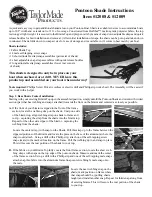
CRIRES User Manual
Doc. Number: ESO-254264
Doc. Version: P109.4
Issued on:
2021-12-01
Page:
69 of 99
Document Classification: ESO Internal Use [Confidential for Non-ESO Staff]
6.4.3 Generic-offsets details
Remember to set the derotator mode (TSF: INS.DROT.MODE) to SKY in the acquisition
template.
·
Number of offset positions
(TSF:
SEQ.NOFF
) gives the total number of telescope positions
that the telescope will have during the execution of the template. Minimum value is 1. If this
value is larger than the number of values listed in
SEQ.OFFSET1.LIST
, or
SEQ.OFFSET2.LIST
then
the list is started again.
For example, if
SEQ.NOFF
= 5,
SEQ.OFFSET1.LIST
= '0 0 0' and
SEQ.OFFSET2.LIST
= '0 10 -10',
with
SEQ.OFFSET.COORDS
= DETECTOR, then the list of offsets will be '0 0 0 0 0' along the X
direction, '0 10 -10 0 10' along the Y direction. At the end of the template, the telescope will
go back to the start location.
·
List of observation types (O or S)
(TSF:
SEQ.OBSTYPE.LIST
) is a list that determines if the
exposure taken once the corresponding offset has been completed is an OBJECT (O) or a
SKY (S) measurement. If the sum of O and S measurement is less than the
Number of
offset positions
(
SEQ.NOFF
), then the sequence will be repeated until the total number of
offsets is reached. For example,
SEQ.NOFF
=7 with
SEQ.OBSTYPE.LIST
=’O O S ’ would result in
an observing pattern 'O O S O O S O'.
Likewise, if the sum of O and S measurements is larger than
SEQ.NOFF
, then the sequence
will be capped when reaching
SEQ.NOFF.
·
Lists of offsets in RA/DEC or X/Y
(TSF:
SEQ.OFFSET1.LIST, SEQ.OFFSET2.LIST
) refer to the
list of offsets being in arcseconds. At the first position, the telescope points to the location
given by
TEL.TARG.ALPHA
and
TEL.TARG.DELTA
plus the first value given in
SEQ.OFFSET1.LIST
and
SEQ.OFFSET2.LIST
.
Subsequent offsets are made relative to the last telescope offset.
·
Offset coordinate type selection
(TSF:
SEQ.OFFSET.COORDS
) determines if the list of
offsets given in
SEQ.OFFSET1.LIST
and
SEQ.OFFSET2.LIST
are given in SKY (unit: arcsec) or
DETECTOR (unit: pixel) coordinates. Keep in mind the pixel scale of the SV detector is
0.0373 arcsec / px.
If
SEQ.OFFSET.COORDS
=
DETECTOR
, then a positive value in
SEQ.OFFSET1.LIST
(X) means
that the telescope will point perpendicularly to the slit towards left (towards E if the position
angle is 0), thereby moving the target from left to right on the SV detector. Similarly, with a
positive value in
SEQ.OFFSET2.LIST
(Y) the telescope will point down, parallel to the slit
(towards S if the PA is 0), thereby moving the target up on the SV detector (see
Figure
41
).
If
SEQ.OFFSET.COORDS
=
SKY
, then a positive value in
SEQ.OFFSET1.LIST
(RA) means that the
new pointing of the telescope will be towards the East (the target moves West on the SV
detector);; similarly, a positive value in
SEQ.OFFSET2.LIST
(DEC) means that the new pointing
of the telescope will be towards the North (the target moves South on the SV;;
Figure
42
).
In case of off-slit guiding, users must
make sure that the SV guide star is within the SV
field of view at all times
(
Figure
27
)!
















































